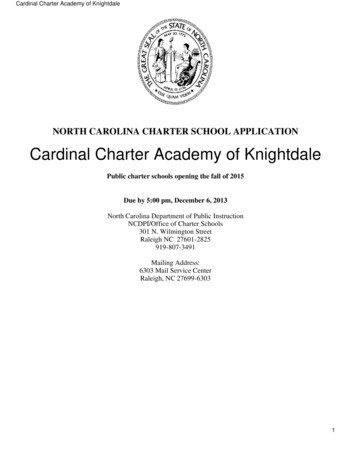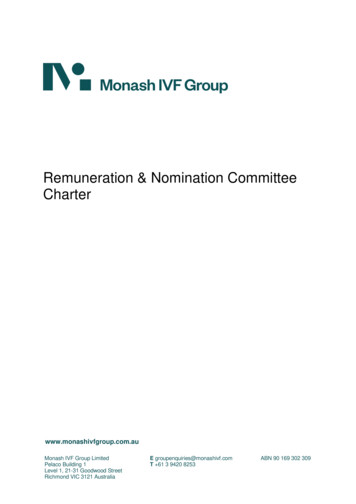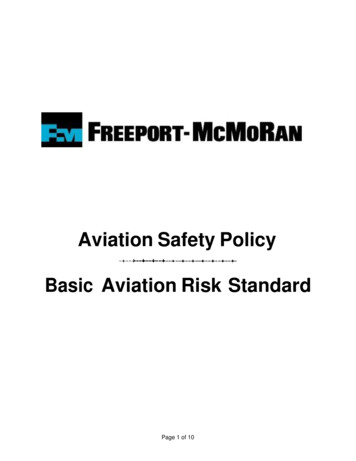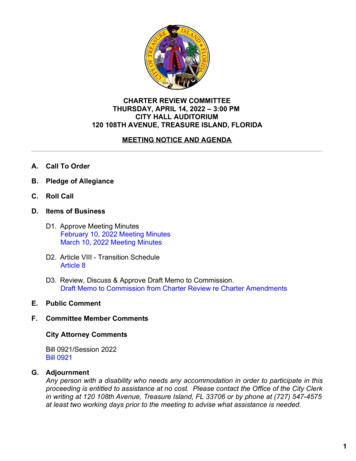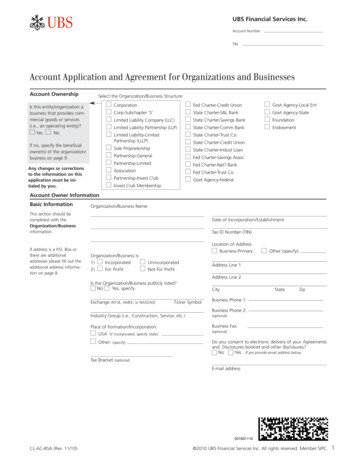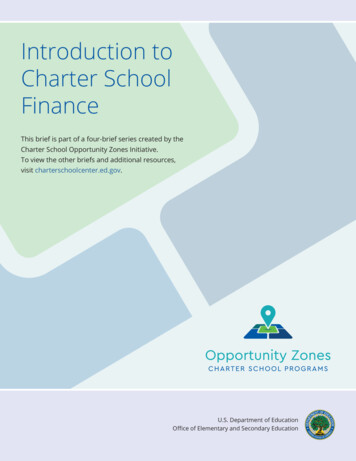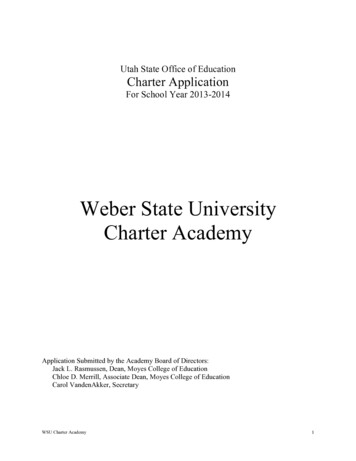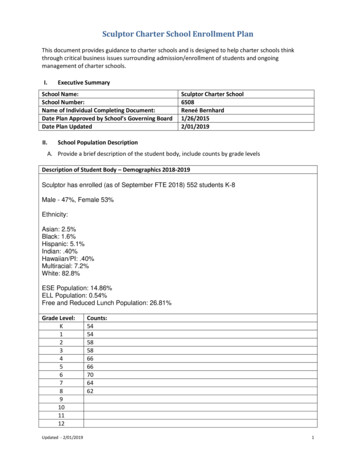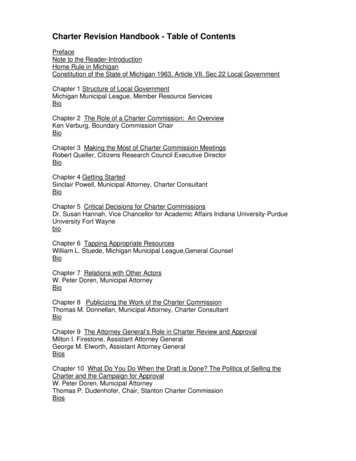
Transcription
COMMUNITY OF INTEREST MODEL CHARTERPart 1: HSIN GOVERNANCE & THIS CHARTER1.1 Purpose of the COI Model CharterThe purpose of this Community of Interest (COI) Model Charter is to ensure that there isconsistent form and content in the governance of COIs across the Homeland SecurityInformation Network (HSIN). This substance and consistency will ensure transparency andaccountability for the whole HSIN enterprise. This COI Model Charter provides all COIs and theHSIN Program Management Office (PMO) with a common reference from which to develop aspecific and final charter (“Charter”) required to govern and manage each COI.Each COI is entitled and empowered to modify and finalize, in close coordination with the HSINPMO, this COI Model Charter, as it requires, to meet its particular, community’s mission needs.The COI Model Charter is a baseline of terms for the governance and management of a COI.Any required changes to the primary terms of this charter, other than the addendum thatdocuments architectural elements of the COI environment, will undergo a re-review and requirea formal approval by the COI Sponsor in coordination with the PMO. HSIN Release 3 will bedeployed using Microsoft SharePoint 2010 platform. This document may leverage terminologyprovided by Microsoft SharePoint 2010.1.2 HSIN Information Sharing & Governance PhilosophyOne of the major goals of HSIN Release 3 and all of its COIs is to ensure that sensitive butunclassified (SBU) information within the system does not become “stovepiped” and that fullavenues for information sharing are in place across all mission areas, levels of government, andnon-governmental partners in the advancement of the purpose of the national InformationSharing Environment. 1 The purpose of HSIN is to provide stakeholders across the HomelandSecurity Enterprise with the means for effective and efficient collaboration for decision making,tiered secure access to data, and accurate, timely information sharing and situational awareness.HSIN, as the designated information-sharing portal for the Department of Homeland Security(DHS) and its security partners 2, serves as the principal platform for consolidation and/orinteroperability with DHS information-sharing portals. HSIN is the only federal portal thatprovides information sharing among DHS and its Federal, State, local, territorial, tribal,international, and private sector partners across the full spectrum of homeland security missions.12ISE Business Model, http://ise.gov/ise-business-model (3/21/12)Secretary Michael Chertoff Memorandum, “Homeland Security Information Network Deployment,” 1/9/6.Page 1
HSIN facilitates information sharing and coordination across all DHS mission areas and supportsthe Emergency Management Community, Critical Infrastructure Community, Law EnforcementCommunity, Intelligence Community, and the DHS relationship with the Department of Defense.To achieve these ends, HSIN seeks only to create those governing bodies and documentsrequired to achieve a network of trust and the efficient, effective management of all forms ofHSIN policy. There are three forms of policy at work within HSIN: Enterprise policy, affectingand used by all elements of the HSIN enterprise; Program policy, effecting and used primarily bythe HSIN PMO; and User policy, effecting and used primarily by HSIN users and theircommunities. The form of HSIN governance is a function of these three types of policy. Thetable below summarizes these policy types in greater detail, with examples.Policy TypePolicyConsumerGoverning and AdvisoryBodiesGoverning RulesExamplesEnterpriseAll elements ofHSINHSIN Executive SteeringCommittee (primary)3HSIN Advisory CouncilESC Charter; Policyon PolicyManagement; PolicyManagement PlanCOI Model CharterProgramHSIN ProgramManagementOfficeSenior Leadership TeamPolicy on PolicyManagement; PolicyManagement PlanPolicy on HSINConnect Users andUsesUser &RequirementsRegisters Users,COIs, MissionAreasCombination – As Required– ESC, SLT, CCB, HUWGand Other User WorkingGroupsCCB Charter;RequirementsManagement Plan;Terms of ServiceCOI CharterTerms of Service;Internal COIManagementTable 1: HSIN Policy TypesTo govern these three policy types, HSIN has established the following governance model, witheach form of governance reflecting the function of each policy type.3NOTE HSIN AC is an FACA committee that provides advice to the HSIN-PMO on requirements that the HSIN-PMOconsiders in-depth because the committee represents the perspective of SLTT, which is the Federal government’sfull partner in homeland security across the US.Page 2
Figure 1: HSIN Governance Decision ModelPage 3
HSIN users, through their COI Sponsors, have a right to engage with the HSIN PMO to addresstheir new system requirements. To do so, Users may engage one of the major user workinggroups noted in the governance diagram above (SEE Figure 1), or, may utilize their MissionAdvocate, Outreach team, or online feedback forms. These technical requirements are managedthrough the HSIN Change Control Board (CCB) and vetted, adopted or rejected through theHSIN Senior Leadership Team (SLT). Should COIs have issue with an SLT requirementsdecision, they may address them through the HSIN Outreach Team, the Change Control Board(CCB) and ultimately, the SLT and the ESC.Full details of HSIN governance and policy management can be found in the HSIN PolicyManagement Business Plan, as kept on file by the HSIN PMO. 41.3 The Relationship of this COI Model Charter to HSIN GovernanceThis COI Model Charter, and the specific missions and Charters of each COI, serve to advancethe Mission of the national Information Sharing Environment (ISE) and of HSIN itself. This COIModel Charter is a function of HSIN Enterprise Policy – it is used and referenced by all elementsof HSIN. When finalized, individual COI Charters will also be a function of Enterprise policy,used and referenced by the COI, its sponsors, users, the HSIN PMO and all other HSINcommunities, to fully establish the terms on which the COI is established, managed, andgoverned, along with the rights and duties of users and the HSIN PMO in relation to theparticular Community. Nothing in this COI Model Charter, any other Charter, nor thearchictecture of HSIN R3 shall be misconstrued so as to conflict with or infringe upon anymission operator authorities or goals, or create inappropriate or inaccurate authorities orrelationships between jurisdiction types or COI sponsors.PART 2: COI ESTABLISHMENT, ORGANIZATION & MANAGEMENT2.1 Purpose of the COIThe purpose of this Charter is to establish the authority, scope, mission and goals, roles,responsibilities and functions for the Homeland Security Information Network (HSIN) [insertmission area/name] 5 COI.a. Authority: [insert]b. Background, history, intent of the COI [insert]4HSIN PMO, “Policy Management Business Plan,” 2012.Items highlighted in yellow are marked so as to indicate particular sections of this template where COIs shall berequired to input their own, original content.5Page 4
c. Mission, Vision and Goals: [insert]2.2 Organization, Governance and Management of the COIThe governance and management of this COI shall be organized and executed through thefollowing form(s) and process(es):[COI to insert a graphic summing up its governance, decision making and managementstructure(s), and to include language summarizing the graphic’s contents, all related roles andtheir duties. A list of mandatory and optional COI roles is provided below in the COI ModelCharter]The following describes the COI Sponsor Roles, Permissioned Roles, and collateral roles thateach Site Group within a COI will establish as the utilization of HSIN by the group requires foreffective management of the Site. These roles leverage the standard Microsoft SharePoint 2010language since HSIN will be utilizing that platform. All modifications to a Site design below aSite Collection6, does not require permission from the HSIN PMO, but Sites must be listed in theaddendum to a COI Charter to ensure clear governance is outlined. Additionally, modificationsof COI and Site designs must adhere to Section 508 requirements and the standard templatedesign guidance provided from the HSIN PMO.2.3 Privileged RolesThese roles are established for users that require elevated permissions to one or more COI. COIsthat request users to obtain a privileged role must provide proper verification that such users aretrained and have knowledge of HSIN specific capabilities. Such roles may be undertaken by oneor more individuals of a COI. Figure 2 illustrates the privileged roles within a COI.6Site collection - A site collection is a group of Web sites that have the same owner and share administrationsettings. Source: 5.aspxPage 5
COI Sponsor -Primary authority over a COI and liaison between its COI and HSINPMO.Site CollectionAdministrator –Granted “full control” ofone or more Siteswithin a Site collectionof a COISiteCommunity of Interest (COI)HSIN Privileged RolesFigure 2: HSIN Privileged RolesPage 6
COI SponsorThe COI Sponsor role defines obligations taken on by a COI Sponsor when establishing a COIwithin HSIN. These obligations, support services, and operational controls provided by the HSINPMO, represents a partnership. The COI Sponsor role is the primary authority over the COI. COISponsors must hold a position from a public sector institution, and that institution must be clearlyrecorded in the COI’s Charter. Each COI must have at least one sponsor. This individual maydelegate the day-to-day implementation and execution responsibilities to a work unit undermanagement control, and that surrogate(s) must be clearly designated in the COI’s Charter. Thisrole establishes and staffs the required roles within their COI, acts as a liaison between its COIand the HSIN PMO, and establishes and updates its COI Charter. This role also approves andsets policies, governance standards, and communicates the established security measures of itsSites. The following duties will be undertaken by the COI Sponsor: Being the primary authority over the COI, sponsors and manages the activities of the COIon HSIN. The individual(s) must hold a position from a public sector institution, and thatinstitution must be clearly recorded in the COI’s Charter. Each COI must have at leastone sponsor. This individual may delegate the day-to-day implementation and executionresponsibilities to a work unit under management control, and that surrogate(s) must beclearly designated in the COI’s Charter.Establishes and staffs the required roles and responsibilities to manage the COI andexecute responsibilities;Ensuring orderly conduct is sustained within their COI and its Sites;Acting as a liaison between its COI and the HSIN PMO;Establishing and updating the COI Charter;Enforcing penalties on its users;Coordinating investigations with the HSIN PMO and HSIN PMO-Security;Validating the action to purge inactive accounts;Validating the action to lock down accounts;Authorizes the HSIN PMO to terminate account(s) within this COI;Approving and setting policies and governance standards to Sites as well as outline theestablished security measures;Monitoring, through technical workflow or delegation to Trusted Vetting Official (TVO)or Content Manager, to ensure duplicate documents do not exist in or are posted fromtheir COI, documents are appropriately tagged, by Federal, state/local jurisdiction forPrivacy, FOIA, and Records Management.Site Collection AdministratorThe Site Collection Administrator role will have the Full Control permission level on all Websites within a site collection. They have Full Control access to all site content in that sitePage 7
collection, even if they do not have explicit permissions on that site. They can audit all sitecontent and receive any administrative alert. A primary and a secondary site collectionadministrator can be specified during the creation of a site collection. HSIN programmatic /technical changes will not override custom permissions and groups as set up by the SiteCollection Administrator. However, if default HSIN values have been changed by the SiteColleciton Administrator, then a HSIN release update may set back permissions to the defaultvalue. This permission level is the highest permission level that can be granted to an end user ofHSIN, but requires a COI to present a business justification to the HSIN PMO and may alsorequire a subsequent HSIN CCB approval to be granted, on a case by case basis.2.4 HSIN Site(s) User Roles 7:These roles are established, permissioned, and staffed by the COI Sponsor. This list of HSINSite(s) User Roles are hierarchical and each role must be adopted for the operation of all Siteswithin a COI. Each HSIN Site may extend additional rights, roles and duties to their particularaccepted users, so long as such are not in contravention of these HSIN Terms of Service or anyother HSIN policy. Users within each Site can maintain multiple user roles. The SharePoint 2010permission levels are identified in the below descriptions of the HSIN Site(s) User Roles anddenoted by the use of quotation marks.7In the future, particular site(s) may adopt the “Permission Manager” role or others, as required. The PermissionManager role will be granted the permissioned role of “Manage Permissions” at the Site level. Stakeholders areeligible to be assigned to the Permission Manager role but HSIN Program support staff will also be assigned to therole in many cases. This role is intended to manage the permissions and groups of its libraries and lists within aSite. For any role assigned to HSIN Program Support staff, the COI Sponsor, or surrogate, must be consulted.These roles include Permission Manager Role, Site Owner, Site Designer, Content Manager ContentApprover, Nominator and Validator. The Permission Manager capability must be available to the SiteCollection Administrator whether or not a Permission Manager role exists. HSIN programmatic /technical changes will not override custom permissions and groups as set up by the Permission Manageror Site Collection Administrator.Page 8
HSIN Site(s) User RolesCollateral RolesSite OwnerPrimary AuthorityPermission Level:Manage Hierarchy / SiteSite AdministratorHas all rights of a Site Owner;does not possess design rights.Permission level: AdminSite DesignerDesigns & creates workspaces, sites, etc.Permission Level: DesignTrusted Vetting Officer: Approves dissemination ofdocumentsNominator: Recommends new usersContent ManagerMaintaining & updating contentPermission Level: Manage ContentContent ApproverApproves release of content for internal disseminationPermission Level: ApproveValidator: Authorizes / approvesrecommended new usersMemberBaseline role of adding content (documents and list items)All enhanced permissions are built on this group.Permission Level: ContributeVisitorViewing items onlyPermission Level: ReadFigure 3: HSIN User RolesPage 9
Site OwnerA Site Owner will be granted the permissioned role of “Hierarchy Manager” and Site Owner atthe Site level. This role is intended to manage the Site infrastructure which includes activitiessuch as creating document libraries, lists, and discussion boards, and shall include permissionsfor SharePoint design, applying style sheets, and applying themes. In select cases, for particularsites, this role may be assigned to HSIN Program support staff through coordination of the COIand the HSIN PMO. Any HSIN COI may request creation of this role and its associatedpermissions levels from the HSIN PMO, however, the role cannot become active without theconsent of the HSIN Outreach Team, based on a business need established by a COI and/or Site.Site AdministratorA Site Administrator shall have all of the rights, duties and permissions of a Site Owner, with theexception that a Site Administrator shall have no rights or permissions for SharePoint design,applying style sheets, nor applying themes. A COI and/or Site may adopt the role of SiteAdministrator at will.Site DesignerA Site Designer will be granted the permissioned role of “Design” at the Site level. Stakeholdersare eligble to be assigned to the Site Designer role but HSIN Program support staff will also beassigned in many cases. This role is intended to manage the look and feel of Site content and theuser interface ensuring that designs do not conflict with required elements of the provided HSINtemplates, and that these designs meet the 508-specific requirements. This role is responsible totake 508 Awareness Training.Content ManagerA Content Manager will be granted the permissioned role of “Manage Content” at the Site level.Stakeholders are eligble to be assigned to the Content Manager role but HSIN Program supportstaff will also be assigned in some cases. This role is intended to manage list and library items.This role is also responsible for marking all content as either “accessible,” meaning it can befound and viewed in full upon being added to the HSIN Shared Space, or as “discoverable,”meaning it can be found by any user through the Shared Space who meets the criteria associatedwith the content but not viewed until a request is approved by the Trusted Vetting Official(TVO) or content owner. “Discoverable” items cannot be found in the shared space withoutbeing promoted to the shared space first. The content owner remains the owner of the documentwhen shared through the Shared Space.Content ApproverA Content Approver will be granted the permissioned role of “Approve” at the Site level.Stakeholders are eligble to be assigned to the Content Approver role but HSIN Program supportPage 10
staff will also be assigned in some cases. This role is intended to approve minor versions of listand library items. This role is responsible for approving the release of content for internal Sitedissemination.MemberA Member will be granted the permissioned role of “Contribute” at the Site level. All users of aSite are eligble to be assigned to the Member role, regardless of their enhanced role. This role isthe baseline role and intended to add, edit, and delete their own library and list items.VisitorA Visitor will be granted the permissioned role of “Read” at the Site level. Users are eligble tobe assigned to the Visitor role in limited cases. This role is intended to view content only andwill have limited operational use.2.5 Collateral Roles:These roles are established and assured staffing by the COI Sponsor. This list of SharePointCollateral Roles are not hierarchical, nor is each role exclusive. Users within each Site canmaintain multiple collateral roles. A Site shall adopt such roles as required for its operations.Such roles may be undertaken by the same individual, or multiple individuals.Trusted Vetting Official (TVO)The TVO role will be granted the permissioned role of “Read” at the Site level. Stakeholderstrained and certified by the HSIN PMO will be assigned to the TVO role but this role will not beassigned to HSIN Program support staff , unless its for a HSIN Program managed Site. The TVOis intended to authorize content publishing from a governed site 8 to the HSIN Shared Space.Each Site must have one primary TVO and may have several alternate.NominatorA Nominator role will be granted the permissioned role of “Read” at the Site level. Stakeholderstrained and certified by the HSIN PMO will be assigned to the Nominator group and HSINProgram support staff will also be assigned in many cases. The Nominator group is intended toprovide initial nomination for end users to a specific governed site. Nominators must be from thesame jurisidiction, jurisdiction-type (e.g. State, local, private), and/or mission type, as themajority of the users within the given Site, (based on the stated purpose of the COI, asdetermined by the COI). Qualified, trained users may perform both the role of a nominator and a8Governed site – A site where access to the Site must be requested of and granted by the Site Owner. Personsobtaining access have the appropriate credentials to access and contribute to content on the Site.Page 11
validator however, they cannot perform both functions for the same registering user. Nominatorsare responsible for recommending potential new users who possess the following criteria: Performs a job function that meets at least one of the homeland security mission areas 9;andHas a valid email address.ValidatorA Validator will be granted the permissioned role of “Read” at the Site level. Stakeholderstrained and certified by the HSIN PMO will be assigned to the Validator role and HSIN Programsupport staff will only be assigned in limited cases. Validators must be from the samejurisidiction, jurisdiction-type (e.g. State, local, private), and/or mission type, (based on thestated purpose of the COI, as determined by the COI), as the majority of the users within thegiven Site. Qualified, trained users may perform both the role of a nominator and a validatorhowever, they cannot perform both functions for the same registering user. Validators areresponsible for confirming a nominated user for the following 10: The nominated user meets the COI’s membership criteria;The nominated user’s email address format is validly entered; andA valid role has been identified.2.6 Modifications to, Enforcement and Recording of the COI CharterIf and when content within this Charter needs to be modified, other than the addendum whichdocuments architectural elements of the COI’s use of HSIN, the COI Sponsor, or its designee,shall consult and obtain agreement from the HSIN PMO of the modifications, formally approveand authorize the changes, and provide a copy to the HSIN PMO. This process will assure themodification’s implementation is in compliance with all HSIN policy. In addition, any additionsto addendums will require consultation and agreement from the PMO prior to modification bythe COI Sponsor or delegated representative. Examples where this Charter may be modifiedinclude, but are not limited to: (1) authoritative role change; (2) revised governance /management structure; and/or (3) revised mission / vision / goals of the COI, and (4) additionand/or removal of Site and/or Site Collections within the COI.The COI Sponsor(s) has enforcement authority over this COI. HSIN PMO empowers the COISponsor to monitor activity in this COI, enforce the provisions the COI’s Charter, and report any9Mission areas: Emergency Management, Law Enforcement, Critical Infrastructure, Emergency Services,Intelligence, and Public Health – HSIN Program Plan 2012-2014 (Final)10HSIN Release 3 User Story ID #348, 4/10/12Page 12
suspicious behavior to the HSIN PMO. If suspicious behavior is dismissed or appropriate actionis not taken, HSIN PMO reserves the right to request a new COI Sponsor to manage the COI andto ensure the integrity of the HSIN enterprise. For further information, please refer to the HSINPolicy on Security Incident Response and/or the Security, Penalties, and Enforcement section ofthis Charter.HSIN PMO shall maintain a copy of the agreed upon Charter leaving the original with the COI.The HSIN PMO retains the right to unilaterally modify the terms of this Model Charterdocument, and must provide notice of such modifications to the entire enterprise.2.7 Joining the COIHSIN maintains strict permissioning controls for use when determining if an applicant formembership to HSIN can become a registered, HSIN user. These controls are designed to upholdthe security and integrity of HSIN. These controls provide users transparency on terms of serviceand make enforcing penalties easier. Users may decline to provide their information during thisinitial review process, but by doing so, their application for access will be rejected and they willnot be provided an account. Upon successful review and authentication, each user will beassigned to a COI.A user can belong to multiple COIs, and for that reason, he/she must be familiar with the termsof service associated with HSIN and be made aware of the rules governing each COI they are amember of by the Sponsors of the COIs they are a part of,including, but not limited to, theirrecords management requirements, privacy standards, and their own responsibilities andobligations as a user of HSIN and as a member of a COI. A user shall have the right toindependently, self-nominate into a particular community of interest, subject to the validationand membership rules of a particular COI. COI Sponsor(s) of this COI shall be responsible forall approving authority of nomination and validation procedures for the COI and its Sites.Nomination and/or validation duties must be approved by an authority within the COI’sestablished management – such duties cannot be delegated to an individual or organizationoutside of the COI’s management structure (e.g. a State COI delegating Nom/Val authority to aFederal agency who is not a COI Sponsor of that COI, unless that person is a member of theCOI). Nominations into COIs will expire after 60 days. After the 61st day, the HSIN user must bere-nominated.The COI Sponsor shall be responsible for accepting the newly nominatedprospective user into its COI. With exceptions, the COI Sponsor should be from the samejurisdiction, jurisdiction type, and/or mission type based on the stated purpose of the COI, asdetermined by the COI), as the majority of the users making up the COI. If there are multiplejurisdictions within a COI, the COI Sponsor must be from the same jurisdiction, jurisdictionPage 13
type, and/or mission type based on the stated purpose of the COI, as determined by the COI), asthe majority of users making up the COI 11. The table below illustrates the list of sample COI’s.DHSComponentsand OfficesDepartments &FederalAgencies Chief Financial Officer (CFO)Citizenship and Immigration Services Ombudsman (CISOMB)Civil Rights and Civil Liberties (CRCL)Customs and Border Protection (CBP)Office of Counternarcotics Enforcement (CNE)Domestic Nuclear Detection Office (DNDO)Executive Secretariat (ESEC)Federal Emergency Management Agency (FEMA)Federal Law Enforcement Training Center (FLETC)Office of the General Counsel (OGC)Office of Health Affairs (OHA)U.S. Immigration and Customs Enforcement (ICE)Office of Inspector General (OIG)Office of Intelligence and Analysis (I&A)Office of Legislative Affairs (OLA)Management (MGMT)National Protection & Programs Directorate (NPPD)Office of Operations Coordination and Planning (OPS)Office of Policy (PLCY)Privacy Office (PRIV)Office of Public Affairs (OPA)Science and Technology (S&T)Transportation Security Administration (TSA)United States Citizenship and Immigration Services (USCIS)United States Coast Guard (USCG)United States Secret (USSS)Federal Bureau of Investigations (FBI)Department of State (DOS)Department of Interior (DOI)Department of Energy (DOE)Department of Veterans Affairs (VA)Department of Defense (DOD)Defense Information Systems Agency (DISA)Defense Intelligence Agency (DIA)11The requirement that a Sponsor(s) be from the same jurisdiction, jurisdiction type, and/or mission type based onthe stated purpose of the COI, as determined by the COI), as the majority of its COI’s user-members should not beinterpreted in any way as to limit cross or multi-jurisdictional information sharing and collaboration. This provisionis provided to ensure the integrity of the nom/val process, having nominators and validators best positioned toperform their duties.Page 14
StatesTerritoriesTribal Defense Security Service (DSS)Department of Agriculture (USDA)Department of Education (ED)Department of Health and Human Services (HHS)Department of Housing and Urban Development (HUD)Department of Justice (DOJ)Department of State (DOS)Department of the TreasuryDepartment of Transportation (DOT)Alabama MontanaAlaska NebraskaAmerican Samoa NevadaArizona New HampshireArkansas New JerseyCalifornia New MexicoColorado New YorkConnecticut North CarolinaDelaware North DakotaDistrict of Columbia Northern Marianas IslandsFlorida OhioGeorgia OklahomaGuam OregonHawaii PennsylvaniaIdaho Puerto RicoIllinois Rhode IslandIndiana South CarolinaIowa South DakotaKansas TennesseeKentucky TexasLouisiana UtahMaine VermontMaryland VirginiaMassachusetts Virgin IslandsMichigan WashingtonMinnesota West VirginiaMississippi WisconsinMissouri WyomingAmerican Samoa Puerto RicoGuam Virgin IslandsNorthern Marianas Islands AlaskaGreat PlainsNorthwest SouthwestEastern OklahomaMidwestPage 15
Southern PlainsEasternNavajo Pacific Rocky MountainWesternTable 2: Sample Communities of InterestIn addition to these controls, this COI maintains additional criteria for admitting new users intoits community. A user applicant into this COI, must possess the following credentials to becomea user-member of this COI: User must support a mission that falls under the national and DHS Information SharingEnvironment (ISE);Vetted to access FOUO information;Adhere to and accept the HSIN Terms of Service[Insert COI’s additional membership criteria.]2.8 User Account RevocationPlease refer to the appropriate section of the HSIN R3 Terms of Service for full details.2.9 Behavior on HSINCOI Sponsors will take responsibility for user compliance to his/her behvavior within their COIand throughout HSIN. 122.10 COI & Site InactivityPlease refer to the appropriate section of the HSIN R3 Terms of Service for full details.2.11 Federated User RightsA federated HSIN user is one whose roles, rights, and privileges have already been vettedsecurely in a federated portal that operates under a federated agreement. This user shall begranted revocable rights to access HSIN using the same credentials as his or her originalfederated portal. Access shall be available via a web browser, mobile device or o
These roles S leverage the standard Microsoft SharePoint 2010 language since HSIN will be utilizing that platform. All modifications to a design below a Site Site Collection. 6, does not require permission from the HSIN PMO,but Sites must be listed in the addendum to a COI Charter to ensure clear governance is outlined. Additionally, modifications
